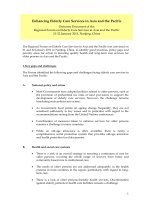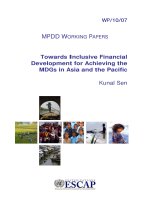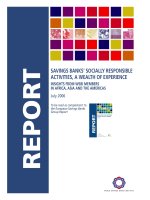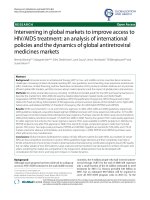Strange parallels southeast asia in global context, c 800–1830 volume 2 mainland mirrors europe, japan, china, south asia, and the islands
Bạn đang xem bản rút gọn của tài liệu. Xem và tải ngay bản đầy đủ của tài liệu tại đây (5.84 MB, 977 trang )
Tai Lieu Chat Luong
This page intentionally left blank
Strange Parallels: Southeast Asia in Global Context, c. 800–1830
Volume 1: Integration on the Mainland
Winner of the World History Association Book Prize
“Strange Parallels will certainly be seen for decades to come as one of
those intellectual enterprises that helped define a generation of thinking
about a particular time and place, in novel and often wonderful ways.”
Eric Tagliacozzo, Cornell University
“This book thus represents a dramatic new stage in the historiography
on early modern Southeast Asia (and Eurasia), setting a demanding
agenda for future researchers that makes earlier approaches appear
almost Jurassic by comparison.”
Michael Charney, School of Oriental and African Studies,
University of London
“Let me say again that this [book] is a masterpiece. . . . It is extremely
important and will, I predict, become a landmark not only in the study
of Southeast Asia but also in the study of early modern world history.”
Li Tana, Australian National University
“A resounding scholarly achievement. . . . His work integrates Southeast
Asian history into the past millennium and puts the region on the global
map.”
Ben Kiernan, Yale University
“This is the most ambitious and challenging effort any scholar has yet
made to bring Southeast Asian history into the mainstream of the human
experience in cogently postcolonial terms.”
Alexander Woodside, University of British Columbia
“This work . . . has an originality which readers have come to expect
from Victor Lieberman. . . . [It] will seal Victor Lieberman’s reputation
as one of the finest historians of South East Asia and, indeed, one of the
most original historians dealing with worldwide comparisons.”
M. C. Ricklefs, National University of Singapore
Strange Parallels
Southeast Asia in Global Context, c. 800–1830
Volume 2: Mainland Mirrors: Europe, Japan, China, South Asia,
and the Islands
Blending fine-grained case studies with overarching theory, this book
seeks both to integrate Southeast Asia into world history and to
rethink much of Eurasia’s premodern past. It argues that Southeast
Asia, Europe, Japan, China, and South Asia all embodied idiosyncratic
versions of a Eurasian-wide pattern whereby local isolates cohered to
form ever larger, more stable, more complex political and cultural
systems. With accelerating force, climatic, commercial, and military
stimuli joined to produce patterns of linear-cum-cyclic construction
that became remarkably synchronized even between regions that had
no contact with one another. Yet this study also distinguishes between
two zones of integration, one where indigenous groups remained in
control and a second where agency gravitated to external conquest
elites. Here, then, is a fundamentally original view of Eurasia during a
1,000-year period that speaks to both historians of individual regions
and those interested in global trends.
Both a specialist in precolonial Burma and a comparativist interested in global patterns, Victor Lieberman graduated first in his class
from Yale University and obtained his doctorate from the School of
Oriental and African Studies of the University of London. His publications include Burmese Administrative Cycles: Anarchy and Conquest,
c. 1580–1760, which won the Harry J. Benda Prize from the Association for Asian Studies; Beyond Binary Histories: Re-Imagining Eurasia
to c. 1830, which he edited and an earlier version of which appeared
as a special issue of Modern Asian Studies devoted to Lieberman’s
scholarship; and Strange Parallels: Southeast Asia in Global Context,
c. 800–1830, Volume 1: Integration on the Mainland, which won the
World History Association Book Prize. He is the Marvin B. Becker Collegiate Professor of History and Professor of Southeast Asian History
at the University of Michigan.
studies in comparative world history
Editors
Michael Adas, Rutgers University
Patrick Manning, University of Pittsburgh
Philip D. Curtin, The Johns Hopkins University
Other Books in the Series
Michael Adas, Prophets of Rebellion: Millenarian Protest Movements Against
the European Colonial Order (1979)
Philip D. Curtin, Cross-Cultural Trade in World History (1984)
Leo Spitzer, Lives in Between: Assimilation and Marginality in Austria, Brazil,
and West Africa, 1780–1945 (1989)
Philip D. Curtin, The Rise and Fall of the Plantation Complex: Essays in
Atlantic History (1990; second edition, 1998)
John Thornton, Africa and Africans in the Making of the Atlantic World,
1400–1800 (1992; second edition, 1998)
Marshall G. S. Hodgson and Edmund Burke III (eds.), Rethinking World
History: Essays on Europe, Islam and World History (1993)
David Northrup, Indentured Labor in the Age of Imperialism, 1834–1922 (1995)
Lauren Benton, Law and Colonial Cultures: Legal Regimes in World History,
1400–1900 (2002)
Victor Lieberman, Strange Parallels: Southeast Asia in Global Context,
c. 800–1830, Vol. 1: Integration on the Mainland (2003)
Kerry Ward, Networks of Empire: Forced Migration in the Dutch East India
Company (2009)
Strange Parallels
Southeast Asia in Global Context, c. 800–1830
Volume 2
Mainland Mirrors: Europe, Japan, China,
South Asia, and the Islands
victor lieberman
University of Michigan
CAMBRIDGE UNIVERSITY PRESS
Cambridge, New York, Melbourne, Madrid, Cape Town, Singapore,
São Paulo, Delhi, Dubai, Tokyo
Cambridge University Press
The Edinburgh Building, Cambridge CB2 8RU, UK
Published in the United States of America by Cambridge University Press, New York
www.cambridge.org
Information on this title: www.cambridge.org/9780521823524
© Victor Lieberman 2009
This publication is in copyright. Subject to statutory exception and to the
provision of relevant collective licensing agreements, no reproduction of any part
may take place without the written permission of Cambridge University Press.
First published in print format 2009
ISBN-13
978-0-511-65854-9
eBook (NetLibrary)
ISBN-13
978-0-521-82352-4
Hardback
ISBN-13
978-0-521-53036-1
Paperback
Cambridge University Press has no responsibility for the persistence or accuracy
of urls for external or third-party internet websites referred to in this publication,
and does not guarantee that any content on such websites is, or will remain,
accurate or appropriate.
To Sharon, forever
Jessica and Brad
Emily and Jeffrey
Marc
Elias
Elijah, Keren, Isaac, Julius, Adira, and Elia
Contents
List of Figures
page xv
Abbreviations Used in the Notes
xvii
Preface
1.
xxi
A Far Promontory: Southeast Asia and Eurasia
1. Rethinking Eurasia
Three Critiques of European Exceptionalism
New Axes of Comparison
2. Political and Cultural Integration in Mainland Southeast
Asia c. 800–1830: A Pr´ecis
Territorial Consolidation: Overview of Mainland Southeast
Asian Political History
Administrative Centralization
Cultural Integration
The Dynamics of Integration: Overview
The Dynamics of Integration: Expansion of Material
Resources
The Dynamics of Integration: New Cultural Currents
The Dynamics of Integration: Intensifying Interstate
Competition
The Dynamics of Integration: Intended and Unintended
Consequences of State Interventions
3. Synchronized Trajectories in Mainland Southeast Asia,
Europe, and Japan: A Preliminary Survey
Idiosyncrasies
ix
1
1
3
9
11
12
22
26
31
32
37
43
44
49
49
Contents
Shared Indices of Integration: Territorial, Administrative,
and Cultural Trends
Pressures to Integration
Factors Promoting Eurasian Coordination
4. Areas of Inner Asian Conquest and Precocious
Civilization: Preliminary Comments on China
and South Asia
The Protected Zone and the Exposed Zone
Similarities Between the Two Zones
Distinguishing Features of China and South Asia
Europeans in India and Archipelagic Southeast Asia
5. Critiques and Caveats
2.
Varieties of European Experience, I. The Formation of
Russia and France to c. 1600
1. Charter Polities, Early and Late, c. 500–1240/1330
Introduction: Distinct Heritages, Comparable Rhythms
Kievan Genesis and Prosperity
Integration and Devolution in the Future Area of
France: The Frankish/Carolingian Charter State,
c. 500–1000
Sources of Renewed Vitality, c. 900–1328:
The Capetian Achievement
Political and Cultural Cohesion in Kiev and
Capetian France
2. Fragmentation, c. 1240–1450
The Poison Fruits of Growth: A Survey of 13th- to
Mid-15th-Century Difficulties
Kiev’s Collapse and the Era of Fragmentation to c. 1450
France, c. 1270–1450: A Conjuncture of Calamities
3. Broad Renewal, Brief Collapse, c. 1450–1613
A New European-Wide Cycle
Muscovite Construction, c. 1450–1580: Mongol-Tatar
Patronage and Decline
Muscovite Construction, c. 1450–1580: Economic and
Military Spurs
Muscovite Construction, c. 1450–1580: Administrative
Creativity
Russian Cultural Integration to c. 1600
x
52
67
77
92
92
93
97
114
117
123
126
126
130
147
154
170
182
182
184
193
205
205
212
217
224
228
Contents
Muscovite Crisis and Disintegration, c. 1560–1613
Factors Promoting the Revival of France, c. 1450–1560
Novel French Political Structures, c. 1450–1560:
Comparisons with Southeast Asia
French Political Identities and Cultural Integration,
c. 1400–1600
French Collapse, 1562–1598: The Wars of Religion
Interim Conclusion
3.
4.
Varieties of European Experience, II. A Great
Acceleration, c. 1600–1830
1. Overview: Wider Differences, Closer Parallels
2. Russian Political and Cultural Trends to c. 1830
Stabilization and Renewal to c. 1650
Pressures to Territorial Expansion and Administrative
Integration: Warfare, New Intellectual Currents, and
Economic Growth, c. 1650–1830
Strengthening the Central State, c. 1650–1830; Frontier
Revolts as a Sign of Success – Comparisons with
Southeast Asia
Cultural Fracture and Integration in the Russian Imperial
Core, c. 1650–1830
Culture and Control on the Imperial Periphery,
c. 1650–1830
3. France During and After the Bourbons
The Construction of French “Absolutism,”
c. 1600–1720: Renewed Integrative Pressures
New Political Structures
Economic Trends c. 1620–1780 and the Problem of
French–Southeast Asian Correlations
The French Revolution and Its Aftermath
French Cultural Integration and Fracture, c. 1600–1830
Conclusion: Europe and Southeast Asia During
a Thousand Years
Creating Japan
1. Overview
2. The Formation and Evolution of an Integrated Polity,
c. 600–1280
Charter Civilization: The Ritsuryo Order to c. 900
xi
238
241
250
257
266
269
271
271
282
282
286
299
306
313
318
318
323
329
340
355
368
371
371
381
381
Contents
The Stability and Longevity of the Charter Order
Evolution of the Heian-Centered Polity,
c. 900 to 1280
3. Devolution and Reintegration, c. 1280–1603
Late Kamakura and Ashikaga Political Tensions,
c. 1280–1467
The Warring States Era and Reunification,
c. 1467–1603
Explaining and Correlating Japanese Reunification,
c. 1450–1600
Warrior Arts, Buddhist Sects, and Oral Literature:
Cultural Trends, c. 1200–1600
4. Tokugawa Idiosyncrasies, 1603–1854
Early Political Vigor
Tokugawa Economic Vitality to c. 1720
Political and Economic Strains, c. 1720–1840;
Overarching Similarities to Other Eurasian Realms
The Dynamics of Cultural Integration Under
the Tokugawa
The Implications of Cultural Change for Japanese
Self-Images and Political Expression
Conclusion
5.
Integration Under Expanding Inner Asian Influence, I.
China: A Precocious and Durable Unity
Why China and South Asia?
1. Similarities Between China and the Protected Zone
Progressively Shorter Interregna: A Pr´ecis of Chinese
Political History
Administrative Integration
Territorial Expansion
Horizontal Cultural Integration
Vertical Cultural Exchange
Economic and Demographic Cycles Coordinated with
Other Sectors of Eurasia: Explaining Synchronization
Comparative Views of the High Qing Economy
2. Differences Between China and the Protected Zone
Distinctive Chinese Features: Civilizational Precocity
Distinctive Chinese Features: Inner Asian Domination
Distinctive Chinese Features: The Burdens of Size
xii
391
398
407
407
411
416
431
438
438
448
457
469
482
490
494
494
497
497
504
519
524
537
548
565
576
576
581
603
Contents
Distinctive Chinese Features: Modest Fiscal and
Military Imperatives
Some Implications of Size and Pacific Environment
Conclusion
6.
Integration Under Expanding Inner Asian Influence, II.
South Asia: Patterns Intermediate Between China and the
Protected Zone
1. Similarities Between South Asia, the Protected Zone,
and China
Progressively Shorter Eras of Polycentrism: Overview of
South Asian Political History
Long-Term Improvements in Administrative Coordination
and Penetration
Territorial Expansion
Horizontal and Vertical Cultural Integration Across
South Asia
Economic and Technological Spurs to Integration
Synchronized with Other Sectors of Eurasia
2. Distinctive Features: Early State Formation, Growing
Inner Asian and British Influence, Persistent
Oscillations
Early Genesis of Civilization
Growing Exposure to Inner Asian Conquest:
An Overview
The Recurrent Prosperity and Decline of Regional
Polities: Why Were Such States Less Stable Than in
the Protected Zone?
Phase One: Regional Florescence and Eclipse,
c. 550–1206/1334
Phase Two: Regional Florescence and Eclipse,
c. 1350–1560/1687
Phase Three: Regional Florescence and Eclipse,
c. 1700–1800/1850
Why Were Empires Less Durable in South Asia Than
in China?
Cohesion and Vulnerability Among Conquest Elites:
Turks and Other Overland Immigrants
Cohesion Among Conquest Elites: The British
Conclusion
xiii
613
622
627
631
635
635
639
656
658
681
705
706
709
713
715
724
733
738
746
757
760
Contents
7.
Locating the Islands
Overview: The Relation of Maritime to Mainland
Southeast Asia
1. The Charter Era in the Archipelago, c. 650–1350/1500
Early State Formation
An Archipelagic Charter State: Srivijaya
Charter States and Civilization in Pre-Muslim Java
Charter State Collapse in the Straits and in Java,
c. 1300–1500
2. Trade, New States, and Islam, c. 1350–1511
Problems of Periodization and Regional Coherence
The Opening Phase of the “Age of Commerce,”
c. 1400–1511: Rising Global Demand
Major Port Polities, c. 1350–1511
Negeri Society, Islamization, and Malay Identity
3. European Interventions in an Era of Multistate Parity,
1511–c. 1660
Archipelagic Prosperity to c. 1640
Europeans as “White Inner Asians”
Creating the Spanish Philippines to c. 1660
Portugal’s Impact to c. 1660
The Dutch in Southeast Asia to c. 1660
Major Archipelagic States, c. 1511 to 1660:
Centralization, Militarization, and Commercial Controls
4. Strengthening the Dutch and Spanish Realms,
c. 1660–1830
A Survey of Dutch Advances to 1784
Explaining Dutch Advances
18th-Century Commercial Dynamism: The Dutch as Victim
Early 19th-Century Upheavals: The Dutch as Phoenix
Cultural Cleavages in the Dutch Conquest State
Political and Cultural Integration in the Philippines,
c. 1660–1830
Conclusion: The Islands and the Mainland
763
763
770
770
772
780
793
797
797
798
802
809
820
820
824
830
837
841
845
857
858
864
868
874
878
883
891
Conclusion
895
Index
909
xiv
List of Figures
1.1
1.2
1.3
1.4
1.5.
1.6
1.7
1.8
1.9
2.1
2.2.
2.3
2.3a
2.3b
2.3c
2.3d
2.3e
2.3f
Mainland Southeast Asia, c. 1340
page 13
Mainland Southeast Asia in 1824
14
Some Elements in the Integration of Mainland Southeast
Asian Realms to 1824 and Their Potential Interactions
47
Territorial Consolidation in Western Mainland
Southeast Asia
58
Territorial Consolidation in Central Mainland
Southeast Asia
59
Territorial Consolidation in Eastern Mainland
Southeast Asia
60
Territorial Consolidation in Russia
61
Territorial Consolidation in France
62
Territorial Consolidation in Japan
62
Russia and Western Siberia
127
France, with Boundaries of the Kingdom in 1789
128
Some Indices of Economic and Demographic Growth in
Southeast Asia and Europe, c. 900–1400
136
Religious Donations at Pagan, 1050–1350
136
Religious Construction at Pagan, 1050–1350
136
Monumental Building in Rus and Its Component Regions,
900–1262
137
Estimated Population Within the Territory of
Contemporary France, 500–1560
137
Medieval Town Foundations in France, Excluding English
Gascony, 1040–1400
138
The Number of French Assarts, 1050–1350
138
xv
List of Figures
2.3g Dates of Town Foundations in Central Europe, 1150–1500
4.1. Japan
4.2 Estimated Populations Within the Territories of
Contemporary Japan and France, 500–1830
4.3 Estimates of Japan’s Total Arable
5.1 China, with Qing Imperial Boundary c. 1820
6.1 South Asia
6.2 South Asian States in the 15th Century
7.1 Archipelagic Southeast Asia
7.2 Java
xvi
139
373
380
426
496
634
725
766
767
Abbreviations Used in the Notes
AC
AHR
BEFEO
BKI
BSOAS
CASS
CC
CEHI
CHAC
CHC, vol. I
CHC, vol. III
CHC, vol. VI
CHC, vol. VII
Anthony Reid, Southeast Asia in the Age of Commerce,
2 vols. (New Haven, 1988, 1993)
American Historical Review
Bulletin de l’Ecole Francaise d’Extreme-Orient
Bijdragen tot de Taal-, Land- en Volkenkunde
Bulletin of the School of Oriental and African Studies,
University of London
Canadian-American Slavic Studies
Climatic Change
Tapan Raychaudhuri and Irfan Habib, eds., The Cambridge Economic History of India, Vol. 1: c. 1200–c. 1750
(Cambridge, 1982)
Michael Loewe and Edward Shaughnessy, eds., The
Cambridge History of Ancient China (Cambridge, 1999)
Denis Twitchett and Michael Loewe, eds., The Cambridge History of China, Vol. 1: The Ch’in and Han
Empires, 221 BC–AD 220 (Cambridge, 1986)
Denis Twitchett, ed., The Cambridge History of China,
Vol. 3: Sui and T’ang China, 589–906 AD, Part 1 (Cambridge, 1979)
Herbert Franke and Denis Twitchett, eds., The Cambridge History of China, Vol. 6: Alien Regimes and Border
States, 907–1368 (Cambridge, 1994)
Frederick Mote and Denis Twitchett, eds., The Cambridge History of China, Vol. 7: The Ming Dynasty, 1368–
1644, Part 1 (Cambridge, 1988)
xvii
Abbreviations Used in the Notes
CHC, vol. VIII
CHC, vol. IX
CHEIA
CHJ, vol. I
CHJ, vol. II
CHJ, vol. III
CHJ, vol. IV
CHJ, vol. V
CHSEA
CIHC
CIHMA, vol. II
CIHMA, vol. III
CSSH
EAH
EHR
FH
FHS
FzOG
HJ
HJAS
HM
Denis Twitchett and Frederick Mote, eds., The Cambridge History of China, Vol. 8: The Ming Dynasty, 1368–
1644, Part 2 (Cambridge, 1986)
Willard Peterson, ed., The Cambridge History of China,
Vol. 9, Part 1: The Ch’ing Empire to 1800 (Cambridge,
2002)
Denis Sinor, ed., The Cambridge History of Early Inner
Asia (Cambridge, 1990)
Delmer Brown, ed., The Cambridge History of Japan,
Vol. 1: Ancient Japan (Cambridge, 1993)
Donald Shively and William McCullough, eds., The
Cambridge History of Japan, Vol. 2: Heian Japan (Cambridge, 1999)
Kozo Yamamura, ed., The Cambridge History of Japan,
Vol. 3: Medieval Japan (Cambridge, 1990)
John W. Hall, ed., The Cambridge History of Japan, Vol. 4:
Early Modern Japan (Cambridge, 1991)
Marius Jansen, ed., The Cambridge History of Japan,
Vol. 5: The Nineteenth Century (Cambridge, 1989)
Nicholas Tarling, ed., The Cambridge History of Southeast Asia, Vol. 1: From Early Times to c. 1800 (Cambridge, 1992)
Patricia Buckley Ebrey, The Cambridge Illustrated
History of China (Cambridge, 1996)
Robert Fossier, ed., The Cambridge Illustrated History of
the Middle Ages, Vol. 2: 950–1250 (Cambridge, 1997)
Robert Fossier, ed., The Cambridge Illustrated History of
the Middle Ages, Vol. 3: 1250–1520 (Cambridge, 1986)
Comparative Studies in Society and History
Ainslie Embree, ed., Encyclopedia of Asian History,
4 vols. (New York, 1988)
Economic History Review
French History
French Historical Studies
Forschungen zur Osteuropaischen Geschichte
Conrad Totman, A History of Japan (Walden, MA,
2000)
Harvard Journal of Asiatic Studies
Barbara Watson Andaya and Leonard Andaya, A
History of Malaysia (2nd ed., Honolulu, 2001)
xviii
Abbreviations Used in the Notes
HMI
M. C. Ricklefs, A History of Modern Indonesia Since
c. 1200 (3rd ed., Stanford, 2001)
HUS
Harvard Ukrainian Studies
IBE
Catherine Asher and Cynthia Talbot, India Before
Europe (Cambridge, 2006)
IESHR
Indian Economic and Social History Review
IHR
International History Review
JAH
Journal of Asian History
JAOS
Journal of the American Oriental Society
JAS
Journal of Asian Studies
JEEH
Journal of European Economic History
JEH
Journal of Economic History
JEMH
Journal of Early Modern History
JESHO
Journal of the Economic and Social History of the Orient
ă Geschichte Osteuropas
JfGO
Jahrbucher fur
JGH
Journal of Global History
JJS
Journal of Japanese Studies
JMBRAS
Journal of the Malay Branch, Royal Asiatic Society
JMH
Journal of Modern History
JRAS
Journal of the Royal Asiatic Society
JSEAH
Journal of Southeast Asian History
JSEAS
Journal of Southeast Asian Studies
JSH
Journal of Social History
JWH
Journal of World History
LCH
Sheldon Pollock, ed., Literary Cultures in History
(Berkeley, 2003)
LIC
Late Imperial China
MAS
Modern Asian Studies
MN
Monumenta Nipponica
ms
manuscript
NCHI
The New Cambridge History of India
NCMH, vol. II
Rosamond McKitterick, ed., The New Cambridge
Medieval History, Vol. 2, c. 700–c. 900 (Cambridge,
1995)
NCMH, vol. VII Christopher Allmand, ed., The New Cambridge
Medieval History, Vol. 7, c. 1415–c. 1500 (Cambridge,
1998)
n.d.
no date
pers. commun. personal communication
PP
Past and Present
xix
Abbreviations Used in the Notes
PPP
RH
RR
SEAR
SEER
SP
SR
SYMT
Paleogeography, Paleoclimatology, Paleoecology
Russian History/Histoire Russe
The Russian Review
South East Asia Research
Slavonic and East European Review
Victor Lieberman, Strange Parallels: Southeast Asia in
Global Context, c. 800–1830, Vol. 1: Integration on the
Mainland (Cambridge, 2003)
Slavic Review
Paul Jakov Smith and Richard von Glahn, eds., The
Song-Yuan-Ming Transition (Cambridge, MA, 2003)
xx
Preface
Not unlike Michel de Montaigne, I found that the more I ate, the bigger
my appetite became.1 Originally I intended to write a one-volume history of mainland Southeast Asia from c. 800 to 1830, with a concluding
chapter suggesting similarities to premodern Russia. But as I read, I
began to sense that mainland Southeast Asia shared critical developmental features not only with Russia but with other far-flung sectors of
Eurasia, and that analysis of those features could help to free Southeast
Asia from the historiographic ghetto in which it had long been confined.
I resolved therefore to supplement mainland history with Eurasian comparisons. Rather than try to cover Eurasia at large, I decided to develop
case studies of Russia, France, and Japan, for it seemed that the history of those regions, focusing on cyclic-cum-linear state consolidation
under indigenous elites, stood closest to patterns in mainland Southeast
Asia’s principal realms, namely, Burma, Siam, and Vietnam.
I still assumed that this would be a one-volume work, albeit a rather
long one. But eventually it became clear that a single volume could not
contain the necessary argument and documentation. With the deeply
appreciated support of Frank Smith, Editorial Director for Academic
Books at Cambridge University Press, I therefore separated the comparative material on Europe and Japan to form a second volume.
The matter, however, did not rest there. When Volume 1 appeared in
2003, the Preface said that Volume 2 would cover Russia, France, Japan,
and island Southeast Asia. As research for those chapters proceeded,
I began to realize that mainland Southeast Asia, most of Europe, and
1
Albert Thibaudet and Maurice Rat, eds., Montaigne: Oeuvres Completes (Paris, 1962), 952.
xxi









